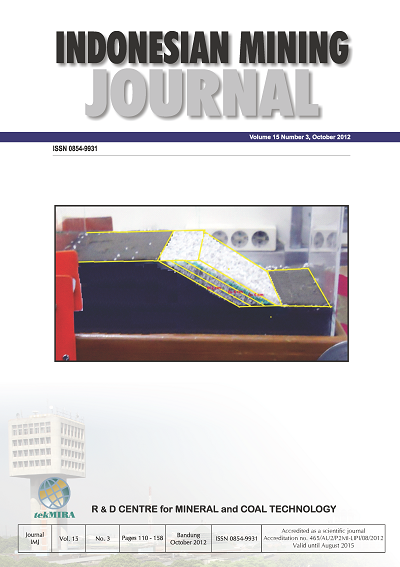MODELS FOR PHYSICAL AND NUMERICAL SLOPE FAILURE OF LOOSE SAND UNDER DYNAMIC LOADING
DOI:
https://doi.org/10.30556/imj.Vol15.No3.2012.447Abstract
Excessive vibration that causes damage to model the medium such as mine slope can physically and numeri- cally be modelled. The slope of this study simply represents the actual view of the slopes that has a smaller size than the actual one, while the numerical model is relates to a mathematical form of slope condition that based on physical and mechanical data of the medium. The slope failure has experimentally been built several variations. Effect of vibration is echieved by connecting the models into the vibration instrument with bearing that can horizontally move free in line within the determined track. The instrument is attached to a spring that can pull the model to side out. The spring is placed in an iron frame. Proviously, the slope has been formed in critical condition one (angle of 30°). Physical model and laboratory test results were used as an input for numerical modelling of the slope failure. Based on the numerical analysis, the SRF was 0.47 for D equal to 2 cm g around 0.0025. If the g’s were around 0.0057 and 0.0088, the obtained SRF for both g’s were 0.44 and
0.41 respectively. While the D of 4 cm and g of 0.0024 came the SRF of 0.54, the g of 0.0064 derived the SRF of 0.48, and the g of 0.0106 obtained the SRF of 0.44. For D equal to 2 cm and g 0.0024, 0.0106; the obtained SRF was 0.54, 0.48 and 0.44 respectively. Increasing the D to 6 cm within variation of g from 0.0025, 0.0062 and 0.0106, the SRF was 0.51, 0.48 and 0.44 respectively. It is assumed that there is a correlation between the thickness of quartz sand layer and the decrease of SRF value. The correlation also occurs between the increase in vibration (g value) and the SRF.
References
Arief, I., 1997. Permodelan Struktur Alamiah, Bidang Spesialisasi Geomekanika, Program Studi Re- kayasa Pertambangan, Program Pasca Sarjana, Institut Teknologi Bandung.
Cai, M., Kaisera, P.K., Tasakab, Y., Maejimac, T., Mo- riokac, H., and Minamic, M., 2004. Generalized crack initiation and crack damage stress thresholds of brittle rock masses near underground excava- tions. International Journal of Rock Mechanics and Mining Sciences, 41(5): 833 847.
Diederichs, M.S., 1999. The role of tensile damage and relaxation, Ph.D. Thesis, University of Wa- terloo: 566.
Hajiabdolmajid, V., Kaiser, P.K. and Martin, C.D., 2002. Modelling brittle failure of rock. International Jour- nal of Rock Mechanics & Mining Sciences, 39(6): 731-741.
Hajiabdolmajid,V., Kaiser,P. and Martin, C.D., 2003. Mobilised strength components in brittle failure of rock. Geotechnique, 53(3): 327 336.
Lu, Y. and Xu, K., 2003. Modelling of dynamic behaviour of concrete materials under blast loading, Interna- tional Journal of Solids and Structures, 41 (2004) 131–143, Elsevier.
Maxwell, S.C. and Young, R.P., 1998. Propagation effects of an underground excavation. Tectono- physics, 289(13): 17 30.
Rocscience Inc., 2001-2004. Application of the finite
element method to slope stability. Toronto.
Sato, T., Kikuchi, T. and Sugihara, K., 2000. In situ experiments on an excavation disturbed zone induced by mechanical excavation in Neogene sedimentary rock at Tono mine, Central Japan. Engineering Geology, 56(1 2): 97 108.
Saiang, D., 2008. Damage rock zone study - A progress report. Technical Report, Lulea University of Tech- nology, Depertment of Civil, Mining and Environ- mental Engineering, division of rock mechanics.
Sheng, Q., Yue, Z.Q., Lee, C.F., Tham, L.G. and Zhou, H., 2002. Estimating the excavation disturbed zone in the permanent shiplock slopes of the Three Gorges Project, China. International Journal of Rock Mechanics and Mining Sciences, 39(2): 165-184.
Stacey, T.R., 1981. A simple extension strain criterion for fracture of brittle rock. International Journal of Rock Mechanics and Mining Science & Geome- chanics. p. 469-474.
Tonon, F., Amadei, B., Pan, E. and Frangopol, D.M., 2001. Bayesian estimation of rock mass boundary conditions with applications to the AECL under- ground research laboratory. International Journal of Rock Mechanics and Mining Sciences, 38(7): 995-1027.
Young, R.P. and Collins, D.S., 2001. Seismic studies of rock fracture at the Underground Research Laboratory, Canada. International Journal of Rock Mechanics and Mining Sciences, 38(6): 787-799.
Downloads
Issue
Section
License
Indonesian Mining Journal provides immediate open access to its content on the principle that making research freely available to the public to supports a greater global exchange of knowledge.

This work is licensed under a Creative Commons Attribution-NonCommercial 4.0 International License.













